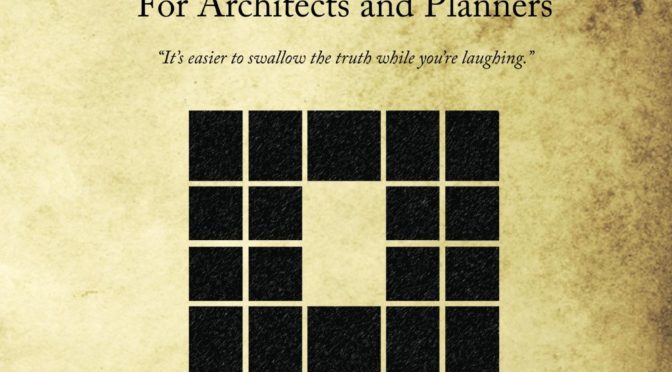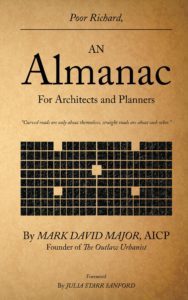Poor Richard, An Almanac for Architects and Planners (2013) offered anew proverbs and witticisms about the architecture, urban design and planning of our cities. It was hailed as a “worthwhile”, “hilariously righteous epitome” for its “genius, extraordinary wit, passion for good design, and mastery of the history of planning” in “following both Benjamin Franklin and Ambrose Bierce” (Review by Harold Henderson, Planning Magazine, February 2014 and Foreword by Julia Starr Sanford to Poor Richard, An Almanac for Architects and Planners).
Poor Richard, Another Almanac for Architects and Planners (Volume 2) brings together more common sense proverbs, astute observations, and general rules of thumb for anyone interested in the future of our cities. In doing so, author Mark David Major again draws from a dizzyingly array of sources for inspiration including the artistic movements of Modernism, obscure African, European and Oriental proverbs, and even the Old and New Testaments. These witticisms are often eloquent, sometimes biting, and always insightful; even occasionally bizarre in the absence of deeper thought. They offer a valuable resource for the entire year, daily reminders for everyone involved in the building of our cities about their better angels and warning against the worse demons of human nature. The clear message of Poor Richard, Another Almanac for Architects and Planners, with foreword by Steve Mouzon (author of The Original Green), is we can do better for our cities and we must do better for our cities.
Purchase you print of digital version today!
 Poor Richard, Another Almanac for Architects and Planners (Volume 2)
Poor Richard, Another Almanac for Architects and Planners (Volume 2)
by Mark David Major, Foreword by Steve Mouzon
140 pages with black and white illustrations.
Available in print from Amazon, CreateSpace, and other online retailers.
Available on iBooks from the Apple iTunes Store and Kindle in the Kindle Store.
For the best digital eBook experience, the author recommends purchasing the iBook version of the book.
 not continuously filled, used, or lived in on a everyday basis for activity, as distinguishable from the storage of things; not occupied, being without content, free from activity; devoid of thought, reflection, or expression; a state of absence; not put to use; also the opposite of full: Middle English, from Anglo-French, from Latin vacant-, vacans, present participle of vacare (to be empty); First Known Use: 14th century.
not continuously filled, used, or lived in on a everyday basis for activity, as distinguishable from the storage of things; not occupied, being without content, free from activity; devoid of thought, reflection, or expression; a state of absence; not put to use; also the opposite of full: Middle English, from Anglo-French, from Latin vacant-, vacans, present participle of vacare (to be empty); First Known Use: 14th century. Purchase your copy of Poor Richard, Another Almanac for Architects and Planners (Volume 2) today!
Purchase your copy of Poor Richard, Another Almanac for Architects and Planners (Volume 2) today!


 meaning extending a great distance from one side to the other; not narrow as measured from side to side; having a specified width; and opened as far as possible over a great or specified distance, area or extent; so as to leave as much space or distance between to the fullest extent.
meaning extending a great distance from one side to the other; not narrow as measured from side to side; having a specified width; and opened as far as possible over a great or specified distance, area or extent; so as to leave as much space or distance between to the fullest extent.
 sustainable cities; of few and scattered elements; especially: not thickly grown or settled, lacking fullness or completeness. Derivative of Latin sparsus meaning spread out, from past participle of spargere to scatter.
sustainable cities; of few and scattered elements; especially: not thickly grown or settled, lacking fullness or completeness. Derivative of Latin sparsus meaning spread out, from past participle of spargere to scatter.


 “Poor Richard” Review | Planning Magazine
“Poor Richard” Review | Planning Magazine